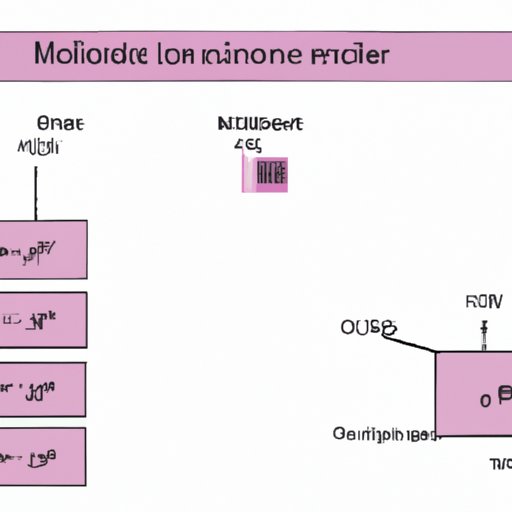I. Introduction
Chemistry is a complex subject that requires attention to detail and precision. One of the fundamental concepts in chemistry is mole calculations, which is a crucial aspect of many chemical reactions. By understanding how to calculate moles, you can accurately measure and predict the outcome of chemical reactions. In this article, we will explore mole calculations in detail, including how to convert between grams and moles, calculating moles using molarity, and mastering stoichiometry. Additionally, we will provide tips for saving time in the lab and avoiding common mistakes in mole calculations.
II. A Beginner’s Guide to Calculating Moles: How to Convert Between Grams and Moles
A mole is a unit of measurement used to describe the number of atoms or molecules in a substance. One mole of a substance is equal to its molecular weight. For example, one mole of water is equal to 18 grams (the molecular weight of water is 18 g/mol). Understanding this concept is essential when converting between grams and moles.
Here is a step-by-step guide on how to convert between grams and moles:
- Find the molecular weight of the substance in grams per mole.
- Determine the amount of substance in grams.
- Divide the mass of the substance in grams by the molecular weight of the substance in grams per mole to obtain the number of moles.
For example, suppose you have 36 grams of carbon dioxide (CO2). The molecular weight of CO2 is 44 grams per mole. To convert grams to moles:
- The molecular weight of carbon dioxide is 44 grams per mole.
- The amount of CO2 is 36 grams.
- Divide 36 grams by 44 grams per mole to obtain 0.81 moles of CO2.
It is always recommended to double-check your calculations to ensure accuracy.
III. The Importance of Molarity: Step-by-Step Guide to Calculate Moles for Chemistry Students
Molarity is the number of moles of solute per liter of solution. It is a critical factor in many chemical reactions because it determines the concentration of a solution and is used to calculate the number of moles. Molarity is used to make solutions ready for use in chemical reactions.
Here are the steps to calculate moles using molarity:
- Determine the molarity (moles per liter) of the solution.
- Measure the volume of the solution in liters.
- Multiply the molarity by the volume in liters to obtain the number of moles in the solution.
For example, if you have a 1 M solution of sodium chloride (NaCl) and a volume of 0.1 liters, the calculation would be:
- The molarity of the solution is 1 mole per liter (1 M).
- The volume of the solution is 0.1 liters.
- Multiply 1 M by 0.1 liters to obtain 0.1 moles of NaCl.
IV. Mastering Stoichiometry: Tips for Calculating Moles in Chemical Reactions
Stoichiometry is the calculation of the quantities of reactants and products involved in a chemical reaction. It is essential for predicting the outcome of a chemical reaction. Moles’ calculations are an integral part of stoichiometry because they are used to determine the quantities of reactants and products involved in the reaction.
The steps to calculate moles in a chemical reaction are:
- Write the balanced chemical equation for the reaction.
- Determine the number of moles of the substance you want to calculate.
- Use the mole ratio from the balanced chemical equation to convert moles of the substance you know to moles of the substance you want to calculate.
For example, if you want to calculate the number of moles of sulfuric acid (H2SO4) required to react completely with 2 moles of sodium hydroxide (NaOH), the balanced equation is:
2 NaOH + H2SO4 → Na2SO4 + 2 H2O
- The balanced chemical equation for the reaction is 2 NaOH + H2SO4 → Na2SO4 + 2 H2O.
- You want to calculate the number of moles of H2SO4 required (the substance you want to calculate).
- Use the stoichiometric ratio and convert the moles of NaOH to moles of H2SO4 (the substance you want to calculate):
2 moles NaOH x (1 mole H2SO4 / 2 moles NaOH) = 1 mole H2SO4
The answer is one mole of sulfuric acid.
V. Saving Time in the Lab: Tricks for Quick and Accurate Mole Calculations
When working in a lab, it is essential to perform mole calculations quickly and accurately. Here are some tips to make mole calculations more efficient:
- Organize your workspace and have all required tools within reach.
- Double-check all measurements and calculations.
- Use electronic balances and volumetric flasks for precise measurements.
- Practice, practice, practice!
VI. Beyond the Textbook: Real-World Applications of Mole Calculations
Mole calculations have many real-world applications. For example, mole calculations are used in medicine to produce drugs and understand pharmacokinetics, in food production to determine the amount of a substance required for a recipe, and in manufacturing to produce chemicals.
One example of real-world applications of mole calculations is the production of aspirin (acetylsalicylic acid). The process to make aspirin involves mole calculations to determine the amount of each reactant to use.
VII. Common Mistakes in Mole Calculations and How to Avoid Them: A Comprehensive Guide
Common mistakes in mole calculations include incorrect numbers, forgetting to balance chemical equations, and using the incorrect unit of measure. These mistakes can lead to inaccurate predictions and results. To avoid these mistakes, carefully read and understand the problem, double-check your calculations, and pay attention to units and significant figures.
VIII. Conclusion
Mole calculations are an essential aspect of chemistry that allows scientists to predict and understand chemical reactions. In this article, we explored the basics of mole calculations, including how to convert between grams and moles, calculating moles using molarity, and mastering stoichiometry. Additionally, we provided tips for saving time in the lab, exploring real-world applications of mole calculations, and avoiding common mistakes. By practicing and mastering mole calculations, you can confidently navigate the complex world of chemistry.
